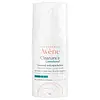What's inside
What's inside
 Key Ingredients
Key Ingredients

 Benefits
Benefits

 Concerns
Concerns

 Ingredients Side-by-side
Ingredients Side-by-side

Water
Skin ConditioningC12-13 Alkyl Lactate
EmollientCitric Acid
BufferingDipropylene Glycol
HumectantCyclopentasiloxane
EmollientSodium Hydroxide
BufferingGlycerin
HumectantMethyl Methacrylate Crosspolymer
Zinc Gluconate
Skin ConditioningSalicylic Acid
MaskingArachidyl Alcohol
EmollientDimethicone
EmollientBehenyl Alcohol
EmollientGlyceryl Stearate
EmollientPEG-100 Stearate
Silica
AbrasiveXanthan Gum
EmulsifyingArachidyl Glucoside
EmulsifyingC30-45 Alkyl Cetearyl Dimethicone Crosspolymer
EmollientHydroxyethyl Acrylate/Sodium Acryloyldimethyl Taurate Copolymer
Emulsion StabilisingGlycyrrhetinic Acid
Skin ConditioningSqualane
EmollientBakuchiol
AntimicrobialSodium Metabisulfite
AntioxidantXylitol
HumectantPropylene Glycol
HumectantPolysorbate 60
EmulsifyingSorbitan Isostearate
EmulsifyingFructooligosaccharides
HumectantMannitol
HumectantPropyl Gallate
AntioxidantCaprylic/Capric Triglyceride
MaskingGinkgo Biloba Leaf Extract
Skin ConditioningRhamnose
HumectantLaminaria Ochroleuca Extract
Skin ConditioningParfum
MaskingWater, C12-13 Alkyl Lactate, Citric Acid, Dipropylene Glycol, Cyclopentasiloxane, Sodium Hydroxide, Glycerin, Methyl Methacrylate Crosspolymer, Zinc Gluconate, Salicylic Acid, Arachidyl Alcohol, Dimethicone, Behenyl Alcohol, Glyceryl Stearate, PEG-100 Stearate, Silica, Xanthan Gum, Arachidyl Glucoside, C30-45 Alkyl Cetearyl Dimethicone Crosspolymer, Hydroxyethyl Acrylate/Sodium Acryloyldimethyl Taurate Copolymer, Glycyrrhetinic Acid, Squalane, Bakuchiol, Sodium Metabisulfite, Xylitol, Propylene Glycol, Polysorbate 60, Sorbitan Isostearate, Fructooligosaccharides, Mannitol, Propyl Gallate, Caprylic/Capric Triglyceride, Ginkgo Biloba Leaf Extract, Rhamnose, Laminaria Ochroleuca Extract, Parfum
 Reviews
Reviews

Alternatives
Ingredients Explained
These ingredients are found in both products.
Ingredients higher up in an ingredient list are typically present in a larger amount.
Glycerin is already naturally found in your skin. It helps moisturize and protect your skin.
A study from 2016 found glycerin to be more effective as a humectant than AHAs and hyaluronic acid.
As a humectant, it helps the skin stay hydrated by pulling moisture to your skin. The low molecular weight of glycerin allows it to pull moisture into the deeper layers of your skin.
Hydrated skin improves your skin barrier; Your skin barrier helps protect against irritants and bacteria.
Glycerin has also been found to have antimicrobial and antiviral properties. Due to these properties, glycerin is often used in wound and burn treatments.
In cosmetics, glycerin is usually derived from plants such as soybean or palm. However, it can also be sourced from animals, such as tallow or animal fat.
This ingredient is organic, colorless, odorless, and non-toxic.
Glycerin is the name for this ingredient in American English. British English uses Glycerol/Glycerine.
Learn more about GlycerinSilica, also known as silicon dioxide, is a naturally occurring mineral. It is used as a fine, spherical, and porous powder in cosmetics.
Though it has exfoliant properties, the function of silica varies depending on the product.
The unique structure of silica enhances the spreadability and adds smoothness, making it a great texture enhancer.
It is also used as an active carrier, emulsifier, and mattifier due to its ability to absorb excess oil.
In some products, tiny microneedles called spicules are made from silica or hydrolyzed sponge. When you rub them in, they lightly polish away dead skin layers and enhance the penetration of active ingredients.
Learn more about SilicaSorbitan Isostearate is an emulsifer and cleaning agent. It is created from isostearic acid and sorbitol.
As an emulsifier, Sorbitan Isostearate prevents oils and water from separating.
Due to its isostearic acid base, it may not be safe for Malassezia or fungal acne.
Learn more about Sorbitan IsostearateWater. It's the most common cosmetic ingredient of all. You'll usually see it at the top of ingredient lists, meaning that it makes up the largest part of the product.
So why is it so popular? Water most often acts as a solvent - this means that it helps dissolve other ingredients into the formulation.
You'll also recognize water as that liquid we all need to stay alive. If you see this, drink a glass of water. Stay hydrated!
Learn more about Water